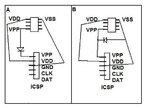wassy
Newbie level 4

- Joined
- Mar 4, 2013
- Messages
- 7
- Helped
- 0
- Reputation
- 0
- Reaction score
- 0
- Trophy points
- 1,291
- Location
- Goucestershire, UK
- Activity points
- 1,388
Hi all,
I have built myself a JDM programmer using a tutorial over at "instructables" which can be found here: Business Card PIC Programmer.
A lot has been written about JDM programmers and from what I can tell, most of the problems people have stem from either too low a VPP voltage, or not pulling down any PGM pins used for low-voltage programming. My problem seems to be rather different from this. First off my desktop COM1 port and the circuit I believe I have faithfully reconstructed seems to be providing 15V on VPP, which is probably too high. Secondly, my current PIC (10F200) for my feeble first steps into the world of MCU programming doesn't appear to have an LVP option or PGM pin according to the datasheet.
The circuit seems to be constructed properly, I am using a desktop tower with COM1 port and under Linux, running the command line version of picpgm. Picpgm autodetects it as a JDM programmer and I tell it to read the PIC to verify if it is blank or not. I get an error
picpgm: /home/christian/picpgm_1751/picpgm/src/common/pic10fxxx.cpp:640: virtual UINT32 CPic10Fxxx::GetOSCCAL(): Assertion `(m_nOSCCAL & 0x0F00) == 0x0C00' failed.
BUT; then something very odd happened, whilst I had the multimeter pressed against the VSS and VPP pins, measuring the DC voltage, the programmer worked!! I was able to read the chip, what's more, I was actually able to program the chip (as long as I had my multimeter leads testing DC voltage between VSS and VPP throughout?!).
Does anyone have any idea why that might be? I thought it might be the high impedance of the multimeter, so tried a variety of 10M, 1M, 100K 22K resistors across VPP and VSS but that did not recreate the same effect as using the multimeter test leads. Can anyone hazard a guess as to why my VPP voltage is also so high?
There is ONE difference to the schematic: For some reason I ended up with a 5.6V zener diode in mine as opposed to a 5.1V zener. I didn't think it would make that much difference to the voltage though. I also have an LED between D1 and Q1 to show when it is programming. Many other JDM circuits also have this LED in them so i didn't think it was a big deviation from the design.
Any help appreciated.
I have built myself a JDM programmer using a tutorial over at "instructables" which can be found here: Business Card PIC Programmer.
A lot has been written about JDM programmers and from what I can tell, most of the problems people have stem from either too low a VPP voltage, or not pulling down any PGM pins used for low-voltage programming. My problem seems to be rather different from this. First off my desktop COM1 port and the circuit I believe I have faithfully reconstructed seems to be providing 15V on VPP, which is probably too high. Secondly, my current PIC (10F200) for my feeble first steps into the world of MCU programming doesn't appear to have an LVP option or PGM pin according to the datasheet.
The circuit seems to be constructed properly, I am using a desktop tower with COM1 port and under Linux, running the command line version of picpgm. Picpgm autodetects it as a JDM programmer and I tell it to read the PIC to verify if it is blank or not. I get an error
picpgm: /home/christian/picpgm_1751/picpgm/src/common/pic10fxxx.cpp:640: virtual UINT32 CPic10Fxxx::GetOSCCAL(): Assertion `(m_nOSCCAL & 0x0F00) == 0x0C00' failed.
BUT; then something very odd happened, whilst I had the multimeter pressed against the VSS and VPP pins, measuring the DC voltage, the programmer worked!! I was able to read the chip, what's more, I was actually able to program the chip (as long as I had my multimeter leads testing DC voltage between VSS and VPP throughout?!).
Does anyone have any idea why that might be? I thought it might be the high impedance of the multimeter, so tried a variety of 10M, 1M, 100K 22K resistors across VPP and VSS but that did not recreate the same effect as using the multimeter test leads. Can anyone hazard a guess as to why my VPP voltage is also so high?
There is ONE difference to the schematic: For some reason I ended up with a 5.6V zener diode in mine as opposed to a 5.1V zener. I didn't think it would make that much difference to the voltage though. I also have an LED between D1 and Q1 to show when it is programming. Many other JDM circuits also have this LED in them so i didn't think it was a big deviation from the design.
Any help appreciated.


